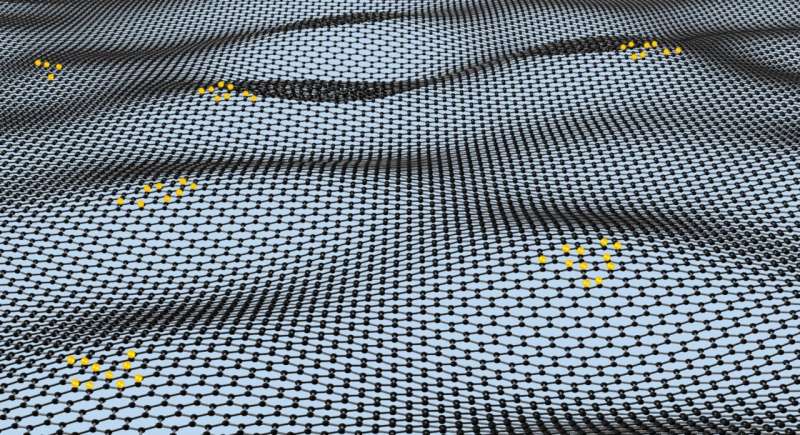
A staff of researchers led by way of Prof. Andre Geim from the Nationwide Graphene Institute (NGI) have found out that nanoripples in graphene could make it a robust catalyst, opposite to basic expectancies that the carbon sheet is as chemically inert as the majority graphite from which it’s bought.
Printed this week within the Lawsuits of the Nationwide Academy of Sciences, the analysis has proven that graphene with nanoscale corrugations of its floor can boost up hydrogen splitting in addition to the most efficient metallic-based catalysts. This surprising impact is perhaps found in all two-dimensional fabrics, which can be all inherently non-flat.
The Manchester staff in collaboration with researchers from China and U.S. performed a sequence of experiments to turn that non-flatness of graphene makes it a robust catalyst. First, the usage of ultrasensitive gasoline go with the flow measurements and Raman spectroscopy, they demonstrated that graphene’s nanoscale corrugations had been connected to its chemical reactivity with molecular hydrogen (H2) and that the activation power for its dissociation into atomic hydrogen (H) used to be somewhat small.
The staff evaluated whether or not this reactivity is sufficient to make the fabric an effective catalyst. To this finish, the researchers used a mix of hydrogen and deuterium (D2) gases and located that graphene certainly behaved as a formidable catalyst, changing H2 and D2 into HD. This used to be in stark distinction to the conduct of graphite and different carbon-based fabrics beneath the similar prerequisites. The gasoline analyses printed that the quantity of HD generated by way of monolayer graphene used to be roughly the similar as for the identified hydrogen catalysts, comparable to zirconia, magnesium oxide and copper, however graphene used to be required simplest in tiny amounts, not up to 100 instances of the latter catalysts.
“Our paper displays that freestanding graphene is reasonably other from each graphite and atomically flat graphene which can be chemically extraordinarily inert. We’ve got additionally proved that nanoscale corrugations are extra necessary for catalysis than the ‘standard suspects’ comparable to vacancies, edges and different defects on graphene’s floor,” mentioned Dr. Pengzhan Solar, first writer of the paper.
Lead writer of the paper Prof. Geim added, “As nanorippling naturally happens in all atomically skinny crystals, on account of thermal fluctuations and unavoidable native mechanical pressure, different 2D fabrics might also display in a similar way enhanced reactivity. As for graphene, we will unquestionably be expecting it to be catalytically and chemically energetic in different reactions, no longer simplest the ones involving hydrogen.”
“2D fabrics are maximum ceaselessly perceived as atomically flat sheets, and results led to by way of unavoidable nanoscale corrugations have up to now been overpassed. Our paintings displays that the ones results will also be dramatic, which has necessary implications for using 2D fabrics. For instance, bulk molybdenum sulfide and different chalcogenides are ceaselessly hired as three-D catalysts. Now we will have to ponder whether they might be much more energetic of their 2D shape.”
Additional information:
P. Z. Solar et al, Surprising catalytic task of nanorippled graphene, Lawsuits of the Nationwide Academy of Sciences (2023). DOI: 10.1073/pnas.2300481120
Quotation:
Nanoripples in graphene could make it a robust catalyst (2023, March 14)
retrieved 16 Might 2023
from https://phys.org/information/2023-03-nanoripples-graphene-strong-catalyst.html
This report is matter to copyright. Excluding any honest dealing for the aim of personal find out about or analysis, no
section is also reproduced with out the written permission. The content material is equipped for info functions simplest.
Supply By way of https://phys.org/information/2023-03-nanoripples-graphene-strong-catalyst.html

